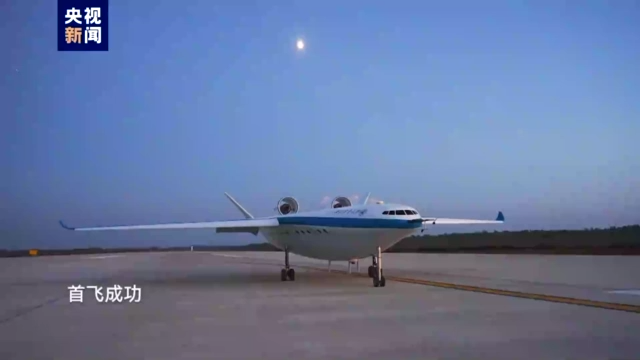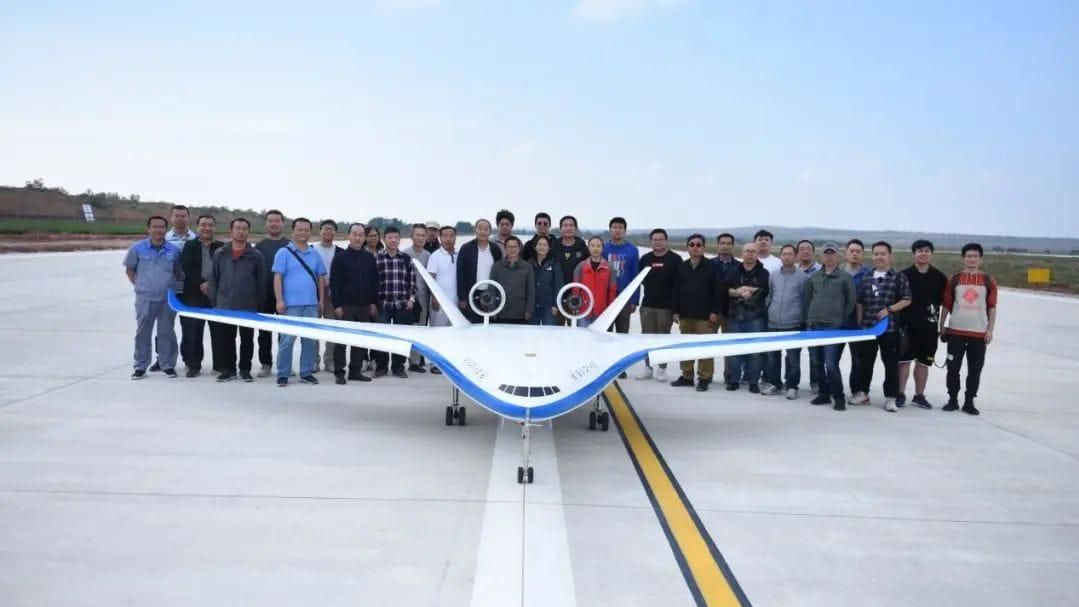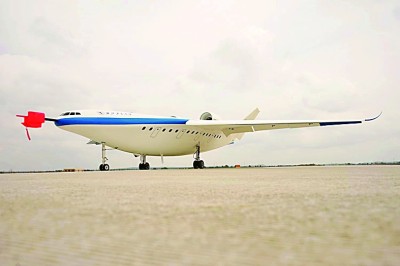
A verification model of a hybrid wing body (HWB), or blended wing body (BWB) large-scale passenger aircraft developed by China's Northwestern Polytechnical University (NPU) has successfully completed its test flight at the Jingbian General Aviation Airport of Yulin City in northwest China's Shaanxi Province. /China Media Group
A verification model of a hybrid wing body (HWB), or blended wing body (BWB) large-scale passenger aircraft developed by China's Northwestern Polytechnical University (NPU) has successfully completed its test flight at the Jingbian General Aviation Airport of Yulin City in northwest China's Shaanxi Province. /China Media Group
A verification model of hybrid wing body (HWB), or blended wing body (BWB) large-scale passenger aircraft developed by China's Northwestern Polytechnical University (NPU) successfully completed its test flight, marking a milestone of the technology verification of such a high-end research concept.
The aircraft model made the test flight at the Jingbian General Aviation Airport of Yulin City in northwest China's Shaanxi Province, carrying out test subjects such as takeoff and landing, passing through the field, autonomous flight of the planned route, and successfully completing the expected flight plan.
"Under the background of continuously increased demand for global air transport , global warming and international energy crisis, the development of green aviation which is more 'economical, environmentally friendly, comfortable and safe' has become a consensus in the international civil aviation field," said Zhang Yongjie, a professor from the School of Civil Aviation of NPU.
The shape of the aircraft developed by NPU has a wide and flat fuselage, which is very streamlined. The transition between the fuselage and the wings is smooth without obvious boundaries, and the cabin is located under the slightly bulging fuselage, said Zhang, adding that this kind of aircraft with integrated wings and fuselage is called HWB aircraft, which is the development direction of future civil aircraft.

A verification model of a hybrid wing body (HWB), or blended wing body (BWB) large-scale passenger aircraft developed by China's Northwestern Polytechnical University (NPU) has successfully completed its test flight at the Jingbian General Aviation Airport of Yulin City in northwest China's Shaanxi Province. /NPU
A verification model of a hybrid wing body (HWB), or blended wing body (BWB) large-scale passenger aircraft developed by China's Northwestern Polytechnical University (NPU) has successfully completed its test flight at the Jingbian General Aviation Airport of Yulin City in northwest China's Shaanxi Province. /NPU
Eco-friendly aircraft with major breakthroughs
Currently, the civil aviation aircraft commonly used across the world is composed of a fuselage similar to a cylinder, wings, empennages and engines.
After decades of development, such a traditional layout, with a clear boundary between the wing and the fuselage, is about to reach its limits on aerodynamic efficiency, and its environmental indicators such as fuel consumption, noise and harmful gas emissions cannot be further reduced.
With a series of key technology verification such as large-scale wind tunnel tests, numerical simulations, and scaled-down flights, the NPU team has overcome and mastered a series of key design technologies such as overall design, aerodynamics, aircraft-engine matching and flight control. Significant progress has been made in technologies such as the special structure of the central body and noise suppression.
The international aviation community has discovered that this highly integrated wing-body civil aircraft has the advantages of high aerodynamic efficiency, light structure weight, large loading space, energy saving, and environmental protection. It is one of the revolutionary technologies and the priority direction for the development of the next generation of wide-body passenger aircraft in the world.
The HWB civil aircraft concept plan formed by the NPU team adopts a single-row 16-seat design to provide passengers with a spacious and comfortable riding environment.
Compared with the current foreign design with a row of 24-30 seats, when the aircraft turns and flies, the passengers sitting on the outside will experience less overload and the ride experience will be more comfortable. At the same time, eight hatches are evenly arranged on both sides of the fuselage, which well meets the requirements of the 90-second golden escape standard.

A verification model of a hybrid wing body (HWB), or blended wing body (BWB) large-scale passenger aircraft developed by China's Northwestern Polytechnical University (NPU) has successfully completed its test flight at the Jingbian General Aviation Airport of Yulin City in northwest China's Shaanxi Province. /NPU
A verification model of a hybrid wing body (HWB), or blended wing body (BWB) large-scale passenger aircraft developed by China's Northwestern Polytechnical University (NPU) has successfully completed its test flight at the Jingbian General Aviation Airport of Yulin City in northwest China's Shaanxi Province. /NPU
Future development orientation
In addition, the NPU team has carried out research on new energy HWB civil aircraft technology, and completed the preliminary design of the hydrogen energy HWB civil aircraft concept scheme.
In the near future, the team will further verify and improve the overall comprehensive design technology of HWB civil aircraft, obtain key technologies such as structure and noise reduction, and focus on new energy aircraft technology.
It will also work on the layout design technology of piggyback (backpack or distributed) engines, providing technical reserves for the development of electric (hydrogen) powered HWB civil aircraft in the next step.